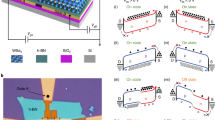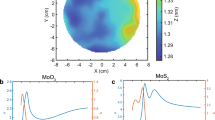Abstract
Non-volatile reconfigurable devices have the potential to improve integration levels and lower power consumption in next-generation electronics. Two-dimensional semiconductors are promising materials for making non-volatile reconfigurable devices due to their atomic thinness and strong gate control, but it is challenging to create varied reconfigurable functions with a simple device configuration. Here we show that an effective-gate-voltage-programmed graded-doping strategy can be used to create a single-gate two-dimensional molybdenum ditelluride device with multiple reconfigurable functions. The device can be programmed to function as a polarity-switchable diode, memory, in-memory Boolean logic gates and artificial synapses with homosynaptic plasticity and heterosynaptic plasticity. As a diode, the device exhibits a rectification ratio of up to 104; as an artificial heterosynapse, it shows heterosynaptic metaplasticity with a modulatory power consumption that can be reduced to 7.3 fW.
This is a preview of subscription content, access via your institution
Access options
Access Nature and 54 other Nature Portfolio journals
Get Nature+, our best-value online-access subscription
$29.99 / 30 days
cancel any time
Subscribe to this journal
Receive 12 digital issues and online access to articles
$119.00 per year
only $9.92 per issue
Buy this article
- Purchase on Springer Link
- Instant access to full article PDF
Prices may be subject to local taxes which are calculated during checkout





Similar content being viewed by others
Data availability
Source data are provided with this paper. All other data that support the findings of this study are available from the corresponding author upon reasonable request.
References
Liu, Y. et al. Promises and prospects of two-dimensional transistors. Nature 591, 43–53 (2021).
Monmasson, E. & Cirstea, M. N. FPGA design methodology for industrial control systems—a review. IEEE Trans. Technol. Soc. 54, 1824–1842 (2007).
Zhao, Z., Rakheja, S. & Zhu, W. Nonvolatile reconfigurable 2D Schottky barrier transistors. Nano Lett. 21, 9318–9324 (2021).
Pan, C. et al. Reconfigurable logic and neuromorphic circuits based on electrically tunable two-dimensional homojunctions. Nat. Electron. 3, 383–390 (2020).
Wang, B. et al. Monolayer MoS2 synaptic transistors for high-temperature neuromorphic applications. Nano Lett. 21, 10400–10408 (2021).
Sangwan, V. K. et al. Multi-terminal memtransistors from polycrystalline monolayer molybdenum disulfide. Nature 554, 500–504 (2018).
Wu, E. et al. Dynamically controllable polarity modulation of MoTe2 field-effect transistors through ultraviolet light and electrostatic activation. Sci. Adv. 5, eaav3430 (2019).
Zhang, S. et al. Lateral layered semiconductor multijunctions for novel electronic devices. Chem. Soc. Rev. 51, 4000–4022 (2022).
Liu, C. et al. Small footprint transistor architecture for photoswitching logic and in situ memory. Nat. Nanotechnol. 14, 662–667 (2019).
Wu, F. et al. Vertical MoS2 transistors with sub-1-nm gate lengths. Nature 603, 259–264 (2022).
Wang, X. et al. Grain-boundary engineering of monolayer MoS2 for energy-efficient lateral synaptic devices. Adv. Mater. 33, e2102435 (2021).
Zhao, B. et al. High-order superlattices by rolling up van der Waals heterostructures. Nature 591, 385–390 (2021).
Chang, Y.-M. et al. Reversible and precisely controllable p/n-type doping of MoTe2 transistors through electrothermal doping. Adv. Mater. 30, e1706995 (2018).
Seo, S.-Y. et al. Reconfigurable photo-induced doping of two-dimensional van der Waals semiconductors using different photon energies. Nat. Electron. 4, 38–44 (2021).
Yang, F.-S. et al. Oxidation-boosted charge trapping in ultra-sensitive van der Waals materials for artificial synaptic features. Nat. Commun. 11, 2972 (2020).
Chen, L. et al. A van der Waals synaptic transistor based on ferroelectric Hf0.5Zr0.5O2 and 2D tungsten disulfide. Adv. Electron. Mater. 6, 2000057 (2020).
Wu, G. et al. MoTe2 p-n homojunctions defined by ferroelectric polarization. Adv. Mater. 32, e1907937 (2020).
Xue, F. et al. Giant ferroelectric resistance switching controlled by a modulatory terminal for low-power neuromorphic in-memory computing. Adv. Mater. 33, e2008709 (2021).
Sun, Y. et al. Versatile logic and nonvolatile memory based on a van der Waals heterojunction. ACS Appl. Electron. Mater. 3, 3079–3084 (2021).
Li, D. et al. Two-dimensional non-volatile programmable p-n junctions. Nat. Nanotechnol. 12, 901–906 (2017).
Huang, W. et al. Gate-coupling-enabled robust hysteresis for nonvolatile memory and programmable rectifier in van der Waals ferroelectric heterojunctions. Adv. Mater. 32, e1908040 (2020).
Lee, S.-J. et al. Programmable devices based on reversible solid-state doping of two-dimensional semiconductors with superionic silver iodide. Nat. Electron. 3, 630–637 (2020).
Xiong, X. et al. Reconfigurable logic‐in‐memory and multilingual artificial synapses based on 2D heterostructures. Adv. Funct. Mater. 30, 1909645 (2020).
Cheng, R. et al. High-performance, multifunctional devices based on asymmetric van der Waals heterostructures. Nat. Electron. 1, 356–361 (2018).
Ruppert, C., Aslan, O. B. & Heinz, T. F. Optical properties and band gap of single- and few-layer MoTe2 crystals. Nano Lett. 14, 6231–6236 (2014).
Zhang, X. et al. Surface charge transfer doping of low-dimensional nanostructures toward high-performance nanodevices. Adv. Mater. 28, 10409–10442 (2016).
Tongay, S. et al. Broad-range modulation of light emission in two-dimensional semiconductors by molecular physisorption gating. Nano Lett. 13, 2831–2836 (2013).
Cho, K. et al. Electric stress-induced threshold voltage instability of multilayer MoS2 field effect transistors. ACS Nano 7, 7751–7758 (2013).
Ding, G. et al. Reconfigurable 2D WSe2-based memtransistor for mimicking homosynaptic and heterosynaptic plasticity. Small 17, e2103175 (2021).
Kang, M. S. & Frisbie, C. D. A pedagogical perspective on ambipolar FETs. ChemPhysChem 14, 1547–1552 (2013).
Sze, S. M. & Ng, K. K. Physics of Semiconductor Devices 3rd edn (Wiley-Interscience, 2007).
Das, S., Dodda, A. & Das, S. A biomimetic 2D transistor for audiomorphic computing. Nat. Commun. 10, 3450 (2019).
Li, E. et al. MXene based saturation organic vertical photoelectric transistors with low subthreshold swing. Nat. Commun. 13, 2898 (2022).
Purves, D. (ed). Neuroscience 6th edn (Sinauer Associates, 2018).
Chistiakova, M. et al. Heterosynaptic plasticity: multiple mechanisms and multiple roles. Neuroscientist 20, 483–498 (2014).
Chater, T. E. & Goda, Y. My neighbour hetero-deconstructing the mechanisms underlying heterosynaptic plasticity. Curr. Opin. Neurobiol. 67, 106–114 (2021).
Fernandes, D. & Carvalho, A. L. Mechanisms of homeostatic plasticity in the excitatory synapse. J. Neurochem. 139, 973–996 (2016).
Abraham, W. C. Metaplasticity: tuning synapses and networks for plasticity. Nat. Rev. Neurosci. 9, 387 (2008).
Bailey, C. H. et al. Is heterosynaptic modulation essential for stabilizing Hebbian plasticity and memory? Nat. Rev. Neurosci. 1, 11–20 (2000).
Nam, J. H. et al. Low power MoS2/Nb2O5 memtransistor device with highly reliable heterosynaptic plasticity. Adv. Funct. Mater. 31, 2104174 (2021).
Huh, W. et al. Synaptic barristor based on phase-engineered 2D heterostructures. Adv. Mater. 30, 1801447 (2018).
John, R. A. et al. Synergistic gating of electro-iono-photoactive 2D chalcogenide neuristors: coexistence of Hebbian and homeostatic synaptic metaplasticity. Adv. Mater. 30, e1800220 (2018).
Seo, S. et al. An optogenetics-inspired flexible van der Waals optoelectronic synapse and its application to a convolutional neural network. Adv. Mater. 33, e2102980 (2021).
Lim, S. et al. Adaptive learning rule for hardware-based deep neural networks using electronic synapse devices. Neural Comput. Appl. 31, 8101–8116 (2019).
Hussain, S., Liu, S.-C. & Basu, A. Hardware-amenable structural learning for spike-based pattern classification using a simple model of active dendrites. Neural Comput. 27, 845–897 (2015).
D’Souza, P., Liu, S.-C. & Hahnloser, R. H. R. Perceptron learning rule derived from spike-frequency adaptation and spike-time-dependent plasticity. Proc. Natl Acad. Sci. USA 107, 4722–4727 (2010).
Wang, L. et al. Artificial synapses based on multiterminal memtransistors for neuromorphic application. Adv. Funct. Mater. 29, 1901106 (2019).
He, C. et al. Artificial synapse based on van der Waals heterostructures with tunable synaptic functions for neuromorphic computing. ACS Appl. Mater. Interfaces 12, 11945–11954 (2020).
Zhang, P. et al. Transition from trap-mediated to band-like transport in polycrystalline monolayer molybdenum disulfide memtransistors. Appl. Phys. Lett. 117, 223101 (2020).
Tian, H. et al. Emulating bilingual synaptic response using a junction-based artificial synaptic device. ACS Nano 11, 7156–7163 (2017).
Lee, H.-S. et al. Dual-gated MoS2 memtransistor crossbar array. Adv. Funct. Mater. 30, 2003683 (2020).
Jadwiszczak, J. et al. MoS2 memtransistors fabricated by localized helium ion beam irradiation. ACS Nano 13, 14262–14273 (2019).
Nguyen, D. A. et al. Electrically and optically controllable p-n junction memtransistor based on an Al2O3 encapsulated 2D Te/ReS2 van der Waals heterostructure. Small Methods 5, e2101303 (2021).
Acknowledgements
We thank Z. Wang, H. Tian and J. Tang for the helpful discussions. This work was financially supported by the Basic Science Center Project of NSFC under grant no. 52388201 (K.L.); the National Key R&D Program of China under grant nos. 2022YFA1203400 (K.L.), 2018YFA0208401 (K.L.) and 2021YFA1200800 (C.W.); and the National Natural Science Foundation of China under grant nos. 51972193 (K.L.), 61925402 (P.Z.), 12241404 (C.S.), 52225106 (C.S.), 62004114 (C.W.) and 62174098 (C.W.).
Author information
Authors and Affiliations
Contributions
K.L. and R.P. conceived the idea and designed the experiments. R.P., Y.W., B.W. and T.P. fabricated the devices. R.P. performed the KPFM measurements. R.P., J.G. and B.Z. carried out the electrical measurements for different device functions. R.P., K.L., R.S., C.S., Z.F., C.W., P.Z. and S.F. analysed the data. R.P. and K.L. drafted the paper. All the authors contributed to the discussions and the final version of the paper.
Corresponding author
Ethics declarations
Competing interests
The authors declare no competing interests.
Peer review
Peer review information
Nature Electronics thanks Ye Zhou, Enxiu Wu and the other, anonymous, reviewer(s) for their contribution to the peer review of this work.
Additional information
Publisher’s note Springer Nature remains neutral with regard to jurisdictional claims in published maps and institutional affiliations.
Extended data
Extended Data Fig. 1 Consecutive reconfiguration of our MoTe2 devices.
a, Consecutive switches of four functions among n-p diode, n-doped state, p-doped state, and homeostatic function of heterosynaptic plasticity. The coloured background regions represent the electrical characterization process of each function and the grey regions mark the reconfiguration processes. Vd/Vg sets of 44 V/15 V, 10 V/−15 V, and 1 V/25 V are applied for the reconfiguration process of n-p diode, n-doped state, and p-doped state, respectively. Positive Vg pulses of 25 V, 0.1 s and negative Vg pulses of −25 V, 0.15 s are applied for the emulation of homeostatic function of heterosynaptic plasticity. b, Rectification ratio of n-p diode, dynamic range of homeostatic function of heterosynaptic plasticity, and channel currents of n-doped state and p-doped state of memory in repeated function switches.
Extended Data Fig. 2 Performance of reconfigurable MoTe2 device under variable environmental conditions.
a, Performance of the device under variable environmental relative humidity. The oxygen content was kept at 20%. b, Performance of the device under variable oxygen concentration. The relative humidity was kept at 10%. All of the measurements were carried out at room temperature. All data are extracted from the corresponding raw data in Supplementary Fig. 27. Rectification ratio is extracted for n-p diode function, on/off ratio for memory, and dynamic range for homeostatic function of heterosynaptic plasticity.
Supplementary information
Supplementary Information
Supplementary Figs. 1–35, Notes 1–12 and Tables 1–3.
Source data
Source Data Fig. 1
Source data for Fig. 1.
Source Data Fig. 2
Source data for Fig. 2.
Source Data Fig. 3
Source data for Fig. 3.
Source Data Fig. 4
Source data for Fig. 4.
Source Data Fig. 5
Source data for Fig. 5.
Source Data Extended Data Fig. 1
Source data for Extended Data Fig. 1.
Source Data Extended Data Fig. 2
Source data for Extended Data Fig. 2.
Rights and permissions
Springer Nature or its licensor (e.g. a society or other partner) holds exclusive rights to this article under a publishing agreement with the author(s) or other rightsholder(s); author self-archiving of the accepted manuscript version of this article is solely governed by the terms of such publishing agreement and applicable law.
About this article
Cite this article
Peng, R., Wu, Y., Wang, B. et al. Programmable graded doping for reconfigurable molybdenum ditelluride devices. Nat Electron 6, 852–861 (2023). https://doi.org/10.1038/s41928-023-01056-1
Received:
Accepted:
Published:
Issue Date:
DOI: https://doi.org/10.1038/s41928-023-01056-1
This article is cited by
-
A reconfigurable single-gate transistor
Nature Electronics (2023)



